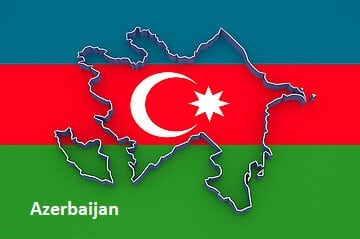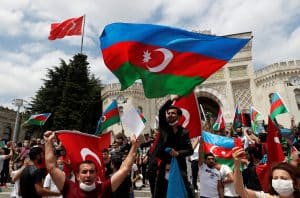Metro
Azerbaijan population, official language and more…

Since then, Azerbaijan has faced various challenges and opportunities, such as the Nagorno-Karabakh conflict with Armenia, the development of its oil and gas industry, the promotion of its cultural heritage, and the integration into regional and international organizations. For example, do you want to know more about the ancient states that existed in Azerbaijan, such as Mannae, Media, Atropatene, Caucasian Albania, and Shirvan? Or do you want to know more about the influence of various empires on Azerbaijan, such as the Achaemenids, Parthians, Sassanids, Romans, Byzantines, Arabs, Mongols, Turks, Safavids, and Qajars? Or maybe you want to know more about the modern history of Azerbaijan, such as the establishment of the Azerbaijan Democratic Republic in 1918, the incorporation into the Soviet Union in 1920, the declaration of sovereignty in 1989 and independence in 1991, or the Nagorno-Karabakh conflict with Armenia?

Azerbaijan
The population According to the World Bank, the population of Azerbaijan was estimated at 10.13 million in 2019. The majority of the population is ethnic Azerbaijani (91.6%), followed by Lezgian (2%), Armenian (1.3%), Russian (1.3%), and other minorities. The population is predominantly Muslim (96.9%), with small Christian (3%) and Jewish (0.1%) communities.
The landmarks Azerbaijan has many natural and cultural landmarks that attract tourists and visitors. Some of the most famous ones are: The Maiden Tower, a 12th-century monument in the Old City of Baku, a UNESCO World Heritage Site. The Palace of the Shirvanshahs, a 15th-century royal complex in Baku, also a UNESCO World Heritage Site. The Gobustan National Park, a site of ancient rock art and mud volcanoes, another UNESCO World Heritage Site. The Heydar Aliyev Center, a modern architectural masterpiece designed by Zaha Hadid in Baku. The Flame Towers, a trio of skyscrapers that symbolize the country’s nickname as the “Land of Fire” in Baku. The Ateshgah of Baku, a fire temple that was used by Zoroastrians, Hindus, and Sikhs in the past. The Yanar Dag, a natural gas fire that burns continuously on a hillside near Baku.
The official language The official language of Azerbaijan is Azerbaijani or Azeri, a Turkic language closely related to and partially mutually intelligible with Modern Turkish. It is spoken by about 92% of the population as a mother tongue. It is written in the Latin script since 1991, replacing the Cyrillic script that was used during the Soviet era. Russian and Armenian are also spoken by some segments of the population, especially in urban areas and Nagorno-Karabakh respectively.
The culture The culture of Azerbaijan is influenced by various Turkic, Iranian, Caucasian, Russian, and Western elements. It has a rich and diverse heritage in literature, music, art, cuisine, and folklore. Some of the notable aspects of Azerbaijani culture are: The mugham, a traditional musical genre that combines vocal and instrumental improvisation with complex rhythms and melodies. The ashik, a bard who sings and plays the saz, a long-necked lute. The carpet weaving, an ancient craft that produces colorful and intricate patterns with symbolic meanings. The Novruz, a spring festival that celebrates the Persian New Year with various rituals and customs. The tea culture, a social practice that involves drinking black tea with sugar or jam and serving it in pear-shaped glasses called armudu. The plov, a rice dish cooked with meat, dried fruits, nuts, and herbs that is considered the national dish of Azerbaijan.
The economic stability Azerbaijan is an upper-middle-income country with a GDP per capita of $4,786 in 2019. It has a resource-based economy that relies heavily on oil and gas exports. It has achieved significant economic growth and poverty reduction since its independence, but it also faces challenges such as diversifying its economy, improving governance and transparency, and managing social and environmental issues. Azerbaijan’s economic stability was affected by the global oil price shock in 2014-2016, which caused a sharp decline in its revenues and foreign exchange reserves. It also faced external pressures from the COVID-19 pandemic and the renewed conflict with Armenia over Nagorno-Karabakh in 2020. To cope with these shocks, the government implemented fiscal consolidation measures, devalued its currency (the manat), increased its public debt, and sought external financing from international organizations such as the World Bank and the IMF. The Central Bank of Azerbaijan has adopted an inflation-targeting regime since 2018 to maintain price stability and support economic recovery. It has raised its policy rate several times since 2020 to curb inflationary pressures and protect the exchange rate. However, inflation is still forecast to average above the Central Bank’s target band of 2%-6% this year due to supply-side factors such as higher food prices and import costs.
The GDP The GDP or gross domestic product is a measure of the total value of goods and services produced in a country in a given period of time. It is often used as an indicator of the economic performance and size of a country. According to the World Bank, Azerbaijan’s GDP was $47.6 billion in 2019, ranking 87th in the world. The GDP growth rate was 2.2% in 2019, but it declined to -4.3% in 2020 due to the COVID-19 pandemic and the Nagorno-Karabakh conflict.
The currency The currency of Azerbaijan is the manat, which is divided into 100 qəpik. The manat was introduced in 1992, replacing the Soviet ruble. The current manat was introduced in 2006, replacing the old manat at a rate of 1 new manat = 5,000 old manat. The ISO code for the manat is AZN, and the symbol is ₼. The exchange rate of the manat against the US dollar as of August 6, 2023 is 1 USD = 1.70 AZN.
The food The food of Azerbaijan is influenced by various regional cuisines, such as Turkish, Iranian, Caucasian, and Russian. It features a variety of dishes made with meat, rice, vegetables, fruits, nuts, herbs, and spices. Some of the most popular and traditional dishes are: Plov: a rice dish cooked with meat, dried fruits, nuts, and herbs that is considered the national dish of Azerbaijan. Kebab: grilled skewers of marinated meat or fish served with bread, salad, and sauces. Dolma: stuffed grape leaves or vegetables filled with minced meat, rice, and herbs. Qutab: thin flatbread stuffed with cheese, spinach, meat, or pumpkin and fried on a griddle. Dovga: a soup made with yogurt, rice, herbs, and meatballs. Shekerbura: a sweet pastry filled with ground nuts and sugar and decorated with patterns.
The major cities Azerbaijan has 78 cities as of 2013, including 10 cities of republican subordination (such as Baku), 67 district-level cities (such as Ganja), and 1 special legal status city (Nakhchivan). The five largest cities by population are: Baku: the capital and largest city of Azerbaijan, located on the Caspian Sea coast. It has a population of about 2.3 million and is a cultural, economic, and political center of the country. Sumqayit: the third-largest city of Azerbaijan, located about 30 km north of Baku. It has a population of about 341,000 and is an industrial hub for chemical and metallurgical industries. Ganja: the second-largest city of Azerbaijan, located in the west of the country. It has a population of about 333,000 and is an ancient city with historical and cultural monuments. Lankaran: the fourth-largest city of Azerbaijan, located in the south of the country on the Caspian Sea coast. It has a population of about 227,000 and is known for its subtropical climate and natural attractions. Mingachevir: the fifth-largest city of Azerbaijan, located in the center of the country on the Kura River. It has a population of about 105,000 and is home to the largest hydroelectric power station in the Caucasus.
The major airport, seaport and schools The major airport in Azerbaijan is Heydar Aliyev International Airport, located about 20 km northeast of Baku. It is named after the former president of Azerbaijan and serves as the main hub for Azerbaijan Airlines. It handles about 4.7 million passengers annually and connects to over 50 destinations worldwide. The major seaport in Azerbaijan is Port of Baku, located on the western coast of the Caspian Sea. It is an important seaport for trade and transportation in the region and handles about





